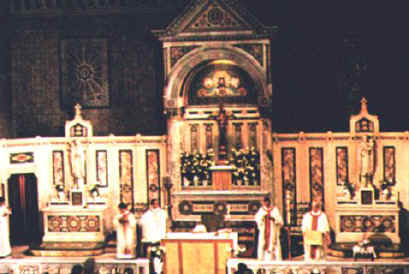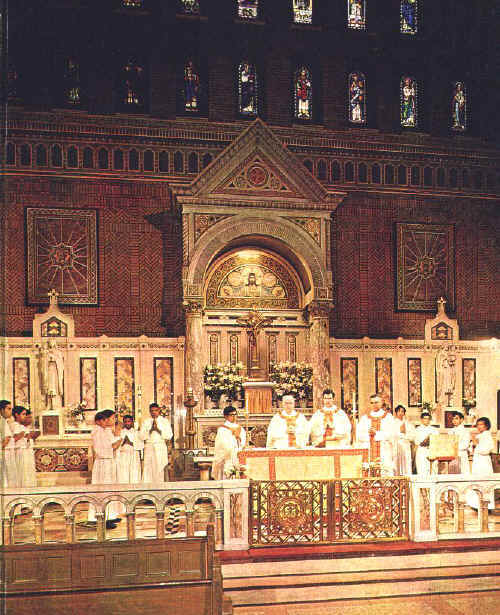|
Holy Trinity Church
Interior
The Sanctuary: Upon entering the church an observer
continues to see the Byzantine style. Multiples of rigid straight lines, exact angles and
geometric patterns endow the sanctuary. Intensely gleaming mosaics and multicolored
marbles of diverse origins offset the rigid lines.
The Altars and Arches: Above the main altar is what
is known as a baldachino, or a marble covering. An arch placed on top of four pillars not
only supports the baldachino, but also continues with the Byzantine motif, as does the
luster of the gold, green, blue, red and white mosaic of the arch.
The two side altars, however, offer a slight change in the motif. Although there is
little doubt that they are of a Byzantine nature, they have been slightly altered away
from the typical ornamented Byzantine form.

The Communion Rail-- Nevertheless, the stylized Byzantine
form is completely used in the church’s communion rail. The Byzantine barrel arch is
contained within the rail. Unlike the pointed Gothic arch and the flat Roman arch, the
Byzantine arch is semi-circle adorned with variously colored marble. This use of
multi-colored marbles and mosaics are also a part of the walls near the church’s
altars. Although the church, due to fiscal reasons, could not fully mimic the ancient
Byzantine practice of covering the entire surface of the walls with mosaics and brilliant
marble, there are two brown and white marble plaques which hint at the original Byzantine
intent.
The Crucifix-- Perhaps the most prominent Byzantine mark
of the Holy Trinity, with the exception of the dome, is the large bronze crucifix. The
twelve-foot crucifix hangs down from an arch on the East Side of the church and defies the
typical modern day representation of Christ. Between the Sixth and Eleventh Centuries,
Christ was shown as attached to the cross, and not hanging forward from it. Thus, Christ
was by no means shown as a suffering figure. Instead, this early Byzantine form represents
Christ as a victorious and unbeaten figure. However, since the Eleventh Century, the
representation of Christ on the Crucifix changed from one of triumph to one of pain and
suffering. [Note also, the use of the initials "I.N.R.I" around the crucifix,
which stands for "Jesus of Nazareth, King of the Jews", a Latin
phrase which shies away from the Byzantine theme.] Since the Byzantines heeded to
the earlier form of representation, the Holy Trinity also chose to honor it. The
church’s Christ is calm and sedate as most Byzantine figures of Christ are displayed.
The crucifix also complies with the Byzantine use of angular figures in detailed costumes
of vivid reds and golds.

Medieval
NewYork | Holy Trinity Main | Byzantine
Architecture | Exterior | Interior
The Internet History Sourcebooks Project is located at the History Department of Fordham University, New York. The Internet
Medieval Sourcebook, and other medieval components of the project, are located at
the Fordham University Center
for Medieval Studies.The IHSP recognizes the contribution of Fordham University, the
Fordham University History Department, and the Fordham Center for Medieval Studies in
providing web space and server support for the project. The IHSP is a project independent of Fordham University. Although the IHSP seeks to follow all applicable copyright law, Fordham University is not
the institutional owner, and is not liable as the result of any legal action.
© Site Concept and Design: Paul Halsall created 26 Jan 1996: latest revision 12 April 2024 [CV]
|